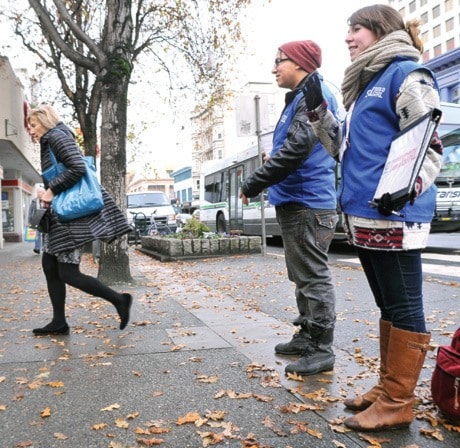Do you have a minute to talk?
This is a typical greeting from one of the young people, wearing a brightly coloured vest bearing a charity’s name.
For some passersby, the question launches a conversation and maybe even a monthly donation.
For others, it causes discomfort and a whole host of avoidance techniques: crossing the street, ruffling through the purse, or simply speeding up while staring at a point in the distance.
Professional canvassers are a common sight in the downtown for the past several years.
For charities, they offer a cost-effective way to raise funds and awareness. But they aren’t without controversy.
Faced with a number of complaints – coming from various sources – Victoria city council took action: it recently voted to review its canvassing bylaws.
“We’ve heard concerns, so let’s review it,” said Mayor Dean Fortin.
On the one hand, canvassing is a legitimate form of fundraising; at the same time council must make sure they are not detracting from our downtown, he said.
Victoria’s streets-collection bylaw was written in 1977.
“Several persons have lately been abusing the privilege of collecting money in City streets, thereby creating a nuisance,” reads the original document, still filed in its original typewriter format.
In essence, the bylaw sets out the need for canvassing organizations to obtain permits, and for canvassers to have various identification.
“Because the bylaw is now 35 years old it is time that it be reviewed,” reads the successful motion put forward by Fortin and Coun. Shellie Gudgeon on Nov. 15.
The purpose of the review will be to better manage solicitations to reduce conflict.
“Instead of having four (canvassers) on every corner, do you say one, so people who actually don’t want to speak to them can have a corner to choose to avoid them if they wish?” asked Fortin.
Don Schaffer, manager of legislative services, receives a small number of complaints through his office every year.
“I get four calls a night for people wanting me to donate,” he said. “I imagine there is some pushback from people who not only get the phone calls at night but (are asked for money) when they are downtown as well.”
Over the years, he has developed some regulations outlining where canvassers can stand. In response to a request from Tourism Victoria, for example, he banned canvassers from standing on Government Street during tourist season.
“These people are being paid to do a job, and they are doing it ostensibly for a good cause so there is a balance you have to strike,” said Schaffer.
Being asked for money – whether by panhandlers or canvassers – is the second most common complaint by tourists, according to recent exit surveys done by Tourism Victoria.
“Not all canvassers are the same,” said Rob Gialloreto, adding some are very polite while some can be more aggressive.
“We have visitors from all over the world and it can be quite shocking for someone to basically step in your way as you are walking down the road with a clipboard and begin to talk to you about a cause that you just don’t have an interest in discussing.”
He supports a review by the city.
But should this review result in significant restrictions, or even a total ban, what’s at stake for the charities?
Save the Children Canada has in the past contracted with Public Outreach, the main professional canvassing company in Victoria since 2005.
So-called “face-to-face” fundraising is more cost effective than television or online ads, said Cisely McWilliams, senior advisory for the charity.
As well as their ability to raise money, canvassers also have a side benefit, she said.
“I think face-to-face provides an opportunity for people to be engaged in a way that makes them aware of not only what the charity is doing but also the broader issues, whether that’s poverty eradication or whether that’s child survival around the world,” she said.
Should a canvasser be overly aggressive, a complaint to the company or charity should resolve the problem, McWilliams said. “I think that you don’t want to be in a situation where the exception to the rule is an avenue to shut down charitable organizations.”
Turning to professional fundraisers makes sense for many charities, added Greg Thomas, director of research for Charity Intelligence Canada.
“The unfortunate thing for most professional fundraising organizations is the ones that make the news are those ones that are not cost efficient,” said Thomas “They are the minority, certainly … I know some do a wonderful job and are well-needed in the sector.”
Public Outreach guarantees its clients a minimum return of $2.50 for every dollar invested, said managing director Bryan McKinnon. Depending on the charity, the guaranteed return could be higher.
Fundraising staff are well-trained, knowledgable and passionate about the issues that people in Victoria care about, he said.
“There is no commission and there is no bonuses, even,” McKinnon said. “I believe strongly that incentivizing people with cash to sign up donors creates aggressive behaviour.”
People don’t need to cross the street to avoid a canvasser, he added.
“They don’t want to talk to you if you don’t want to talk to them. If you just said ‘no thank you,’ that’s it. They are not going to block your way or chase after you.”
rholmen@vicnews.com
At a glance
The City of Victoria doesn’t cap the number of canvassers or regulate the way they approach people for money. It does, however, regulate where they can stand.
They may not canvass:
• in parks, on Government Street, or in the inner harbour
• in the same location on two consecutive days
• in any intersection if two canvassers already present
• in business doorways or private spaces
